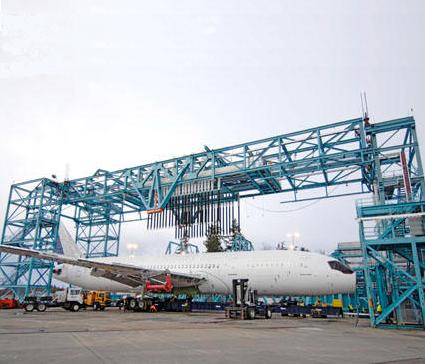
| NEWSROOM |
|
|
 |
|
|
|
|
|
|||
|
By Daniel Baxter |
||||
 |
February 3,
2010 - “Unlike static tests, where loads are applied to the airplane
structure to simulate both normal operation and extreme flight
conditions, fatigue testing is a much longer process that simulates up
to three times the number of flight cycles an airplane is likely to
experience during a lifetime of service,” said Scott Fancher, 787 vice
president and general manager, Commercial Airplanes. “This testing is
instrumental in confirming the longevity of the airplane.” On Sunday
Boeing moved the 787 Dreamliner fatigue test airframe to its structural
test rig. The test rig is located in the northwest corner of the The Boeing team continues to meet their milestones. Recently Boeing 787 Dreamliner pilots conducted the program's first stall tests in which pilots intentionally reduce power to both engines and then recover normal flight speeds - as part of the initial airworthiness program for the airplane. Additional stall tests will take place throughout the flight test period. |
|||
|
The testing went "very well and there were no surprises," said 787 Chief
Pilot Mike Carriker. The purpose of the testing was to demonstrate that
in the rare event a pilot encounters a stall during flight, the airplane
reacts benignly and allows for a smooth recovery. A stall is defined as
flying so slowly that the airplane is no longer generating lift. During
stall maneuvers pilots use a disciplined process to slow the airplane
down at precise increments to the point where it shakes dramatically,
resulting in forces of 1.5 times the force of gravity. In mid January Boeing completed initial airworthiness testing on the 787 Dreamliner. This milestone will enable more crew members to take part in flights and will allow more airplanes to join the flight test program. "This is an important step forward," said Scott Fancher, vice president and general manager of the 787 program, Boeing Commercial Airplanes. "We are very pleased with the results we have achieved so far. The airplane has been performing as we expected." |
||||
|
Since the first
flight in mid-December, the program has conducted 15 flights, achieving
several key accomplishments. Pilots have taken the airplane to an
altitude of 30,000 feet (9,144 m) and a speed of Mach 0.65. Nearly 60
hours of flying have been completed. Initial stall tests and other
dynamic maneuvers have been run, as well as an extensive check-out of
the airplane's systems. Six different pilots have been behind the
controls of the 787. In the weeks
ahead, the team will continue to expand the flight envelope at which the
787 will operate to reach an altitude of more than 40,000 feet (12,192
m) and a speed of Mach 0.85. Subsequent testing will push the airplane
beyond expected operational conditions. |
| ©AvStop
Online Magazine
Contact
Us
Return To News
|
|